You might have heard a very common don’t-chase-trends-and-be-yourself tip. While this is a good approach, it doesn’t work all the time. If you want to create an effective design for your website, studying trends is crucial to your success. Trends are much more than just fly-by-night whims. They are a very valuable source of information on what appeals to customers and, therefore, drives traffic, conversion, and sales.
Web design trends of 2018
Do you remember the law of conservation of energy? It says that energy can’t be created or destroyed; it can only be transformed from one form to another. This rule can be applied to trends as well. New trends are not exactly “new”. They are a continuation of the previous tendencies. Let’s go one year back in time and see what web design trends shaped the industry in 2018.
Shades
After a lengthy dominance of flat design, shades came back to fashion. Smart mixes of flat background and three-dimensional objects became very popular. Shades varied by color, saturation, and length.
Illustrations
An illustration is a photo or image that tells a story about your brand, visualizes your offer, outlines your business advantages, etc. In 2018, designers took a particular liking to decorative illustrations that created strong associations with the brand.
Vibrant colors and gradients
In 2018, saturated colors and merry gradients took web design by storm. To render web interfaces more realistic, designers used varying opacity to add depth and volume to gradients. Instagram logo is a perfect example of the trend.
Animations
Animations can fully transform your content, making it more interactive and dynamic. Animations are a great way to engage your audience and boost their loyalty. Plus, animation techniques allow users to study products on your website by rotating them, changing their color, etc.
Adaptive design
Adaptive design makes sure your website is displayed correctly across different devices. This new trend was booming in 2018. For example, Google, Coca-Cola, Chanel, Walt Disney, Levis, and other brands created the reduced versions of their iconic logos to adapt to the needs of their mobile audiences.
Variable fonts
Variable fonts were first introduced in 2016 by such giants as Microsoft, Apple, Adobe and Google. The new OpenType 1.8 technology allowed to store all types of fonts in a single file and use more accurate type values. Two years later, in 2018, variable fonts were still at the forefront of the web design industry.
Asymmetry VS two-dimensional grids
In 2018, web design was torn between two methods for arranging elements on a web page. The first one was asymmetry that transcended creativity and chaos. Asymmetry was opposed by CSS Grid Layout that created smooth, proportional designs by overlaying elements onto a two-dimensional grid.
Web Design Trends 2019
Year 2019 is about to turn the corner. Now is the best time to see how web design industry has changed over the last 12 months. Let’s take a look at the list of top popular web design trends of 2019.
Asymmetrical mockups
Asymmetry has earned the status of an undying classic. Lack of symmetrical lines makes a design more emotional and memorable. This is a great way to convey your company personality. Contrary to a common opinion, asymmetry can create a fine balance by contrasting unexpected shapes and hues.
Geometric shapes
While rounded forms are commonly used to craft a subtle, welcoming design, shapes with acute angles convey the idea of professionalism and reliability. Nowadays, geometry is something you can come across on any website!
Retro typography
Nostalgia urges designers to reinvent the iconic fashion trends of the past years. Pastel tones, wooden textures, embossed fonts, exquisite shades, retro images….The new generation of users don’t mind a journey back in time!
Monochrome images
In 2019, instead of using different hues, designers experimented with shades of the same color. You can’t go wrong with this approach because matching hues create a balanced design.
Overlapping elements
This trend is closely related to asymmetry. Different elements violate each other’s boundaries and create partial overlappings. This happens, for example, when you’re adding text onto a background image.
Negative space
There were times when having an unused blank space on your design was attributed to lack of professionalism. Nowadays, negative space is a smart visual trick that catches the eye and emphasizes vital information.
Unusual typography
Due to coding issues, using unconventional fonts on a web page is tricky task. Nonetheless, lost fragments, negative space, and animations, and other typography-related tricks continue to have a big fan base.
Micro interactions and mini games
Web interfaces are becoming increasingly user-friendly, attracting users with merry animations and humor. Interactions between small animated elements make a website look unique. As for mini games, they entertain users while the page is loading.
Combinations of fonts
On the same web page, you can come across fonts of varying forms and weights. For example, elegant fonts look great with massive ones. This trick makes the text more expressive, creating a visual hierarchy and highlighting important parts.
Big paragraphs
Paragraphs have become a common part of web design. In 2019, designers were exploring the potential of big paragraphs, combining them with dynamic decorative fonts.
Animated elements
Animated elements have the power to boost the aesthetics and usability of your website. Now it’s not uncommon to see icons move when you click on them or fields tremble when your submit incorrect data. While a page is loading, a user can see eye-catchy elements moving all over the page.
Brutality
Brutality was first introduced to web design in fonts, mockups, and micro interactions. In 2019, this trend affected interface usability as well. Nowadays, vibrant colors, unexpected animations, and massive fonts can be found on many websites.
Distortion and waves
Designers first used shader effects (aka fluid effects) in text, video, and other interface elements. While some experts predicted a quick death to this trend, its growing popularity proves just the opposite.
Mixed scrolling
Let’s admit it: vertical scrolling is boring. Now, the page content can be scrolled horizontally and diagonally as well. Thanks to animations and other effects that come up while scrolling, all the elements on a page are moving in a single flow.
2D and 3D effects
In СSS animation, there is such thing as “parallax effect”, when elements in the foreground are shifted faster than those in the background. This effect is achieved through using 3D modelling on 2D surfaces. This is how you can create a contrasting effect between voluminous and flat graphics, colors, and text.
Brand personality
Websites resemble people, don’t you think? Depending on your brand personality, you need to choose the tone in which you’re going to communicate with your audience. Modern designers share the opinion that standard notifications and other micro copies are no longer relevant. What modern websites need is more humor and emotions.
PWA
PWA, or Progressive Web Application, was a breakthrough technology of 2018. One year later, PWA has become a trend in its niche. Used on smartphones and tablets, the program features a full functionality of a website, provides offline access to your web pages, and has a bunch of other useful features.
Virtual voice assistants
Virtual voice assistants, such as Siri and Google Assistant, help users perform a variety of tasks, from entering a text to making settings to searching information on the web. Now these smart algorithms can perform commands via smartphones.
Web Design Trends 2020
How about taking a sneak peek into the future? Are you with us? Below, we’ve outlined the hottest trends predicted for 2020. Overwhelmed with sweeping technological advances, we expect technologies to be more amiable and friendly to us humans.
Micro animations
Animation is nothing new in web design. However, in 2020, animations will take up bigger roles, interacting with users and guiding them through the content. While small in size, moving elements will be organically incorporated into website design.
3D modelling and rendering
When innovations become available to a wide public, they transform into trends. This is exactly what happened to 3D modelling and rendering after its price had went down. Although catchy and mesmerizing, 3D designs slow down your web pages and undermine the quality of graphics.
Nature-inspired shapes
Fluid forms represent a bold rebellion against conventional rigid lines. In 2020, web designers will be imitating nature more than ever. Tired of strict geometric shapes from 2019, we expect to see more flowing, nature-inspired forms.
Big headlines
Users are spending less and less time on websites. This alarming tendency urges web designers to use clever tricks in order to retain visitor attention. In the upcoming year, get ready for big, noticeable headlines. By using this technique, website owners hope to increase time spent on the website and conversion.
Negative space
The all-familiar negative space will be maintaining its positions in 2020. Intervals between the elements can be active and passive. While active intervals are used for better navigation, passive intervals allow the user eye to relax.
Bright colors and minimalism
Minimalism combined with saturated hues is never boring. In 2020, prepare to see a wonderful fusion of simple graphics and vibrant, screaming colors.
Careful use of colors
According to psychology of colors, each shade affects a person in a different way. In 2020, designers will continue to explore the incredible power of hues. However, this time, the choice of colors will be preceded by a deep analysis of the target audience.
Interactive storytelling
Today, interactivity is everywhere. Interactive web design is a clever way to arrest the attention of users and pique their interest. Paired with interactive graphics, the storytelling technique can generate amazing conversion rates.
Big thumb navigation
Today, desktops and laptops can’t beat smartphones in terms of popularity. Since people are mostly using their big thumb to navigate web pages on their smartphones, designers will have to come up with a “big-thumb-friendly” web design.
Videos
Adding a video clip is another way to make users stay on your website a little longer. However, today a simple video is not enough. In 2020, prepare to see lots of engaging and original video content.
Chat bots
Chat bots are continuing to evolve. A couple of years ago, the only talent of chat bots was to the ability to answer simple questions. Today, these smart algorithms can do much more, and we can’t wait to see what 2020 holds in this regard!
Accessibility for the disabled
All fields of life have become more friendly towards people with reduced capabilities, and web design is no exception. In 2020, companies will continue to adapt their web pages to the needs of the disabled.
Augmented reality
The AR technologies are on the rise, and we’re stoked to see the evolution of this amazing innovation. The AR technology fully complies with iOS and Android devices, which makes it available to all categories of users.
Isometric illustrations
Isometric illustrations have a secure spot on the list of web design trends. When positioned on 2D surfaces, isometric illustrations lose their realistic feel. Judging by the fast development of this trend, these beautiful 3D models will become even more impressive in 2020.
Process spectrum
In the upcoming year, we’ll see more of this promising trend. It allows you to outline the steps a user must perform to achieve a specific goal. By using process spectrum, you take care of your visitors, making their user experience on your website more logical and coherent.
We’re happy to see how web design is adapting to the needs and personal traits of each user. This is, hands down, the most vital trend of the last years that will continue all the way into 2020. Be sure to remember that when developing your corporate website.






